Laser engraving cork is a creative and sustainable way to personalize natural materials — from coasters and wine stoppers to wall art and signage. Cork engraves beautifully, leaving behind clean, dark, and precise marks that contrast naturally with its light tan color.
Whether you’re a hobbyist or small business owner, learning how to engrave cork properly will open up endless design possibilities.
Table of Contents
Why Cork Is Perfect for Laser Engraving
Cork is made from the bark of the cork oak tree and is 100% renewable. Its unique cellular structure makes it lightweight, durable, and easy to engrave. Because cork is soft and porous, laser engraving removes just enough material to reveal detailed text, logos, and artwork without burning too deeply.
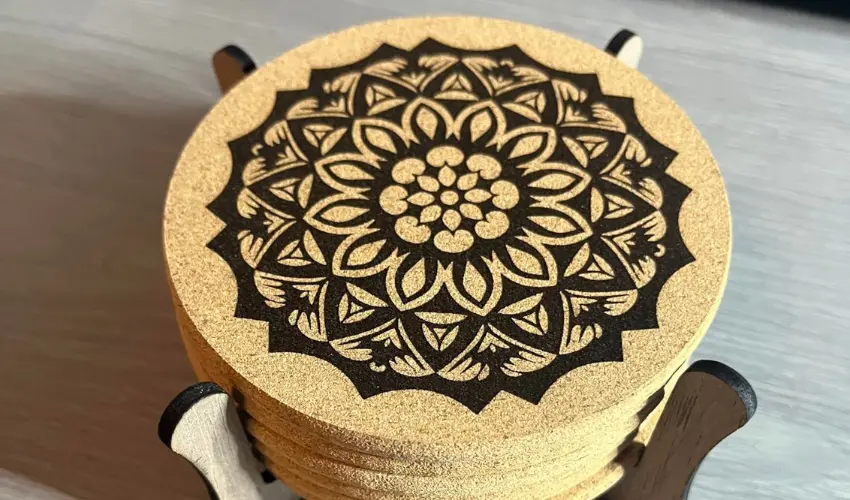
Key Benefits:
- Eco-friendly and sustainable material
- Lightweight, flexible, and easy to work with
- Produces excellent engraving contrast
- Low smoke output compared to other woods
- Affordable and widely available
Best Lasers for Engraving Cork
Not all lasers handle cork equally. Depending on your goals — from small craft projects to professional product engraving — the right laser machine makes a huge difference in precision, contrast, and production speed.
Below is a comparison of the best xTool laser machines for engraving and cutting cork, including their strengths, ideal uses, and pricing (USD).
1. xTool P2S CO₂ Laser Cutter – Best Overall for Laser Engraving Cork
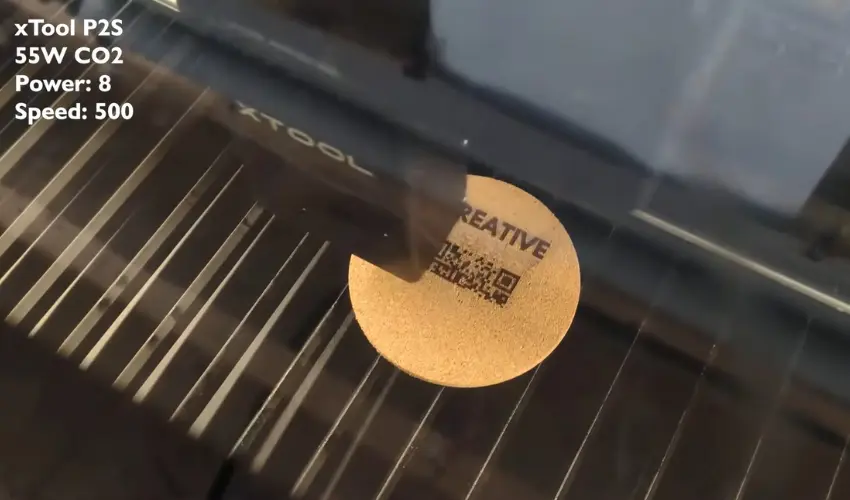
Price: ~$3,799 USD
Laser Type: 55W CO₂
Best For: Professional cork engraving, cutting thick cork sheets, and large-batch production
Why It’s Great:
- The 55W CO₂ laser produces clean, deep engravings on both natural and composite cork.
- Large 26″ × 14″ workspace — ideal for bulk coaster sets, signage, or wall art.
- Smart autofocus and dual cameras make alignment effortless.
- Works perfectly with the xTool AP2 Air Purifier for fume control.
Recommended Use:
- Custom home décor, cork tiles, and product branding.
2. xTool S1 40W Diode Laser – Best for Crafters & Small Businesses
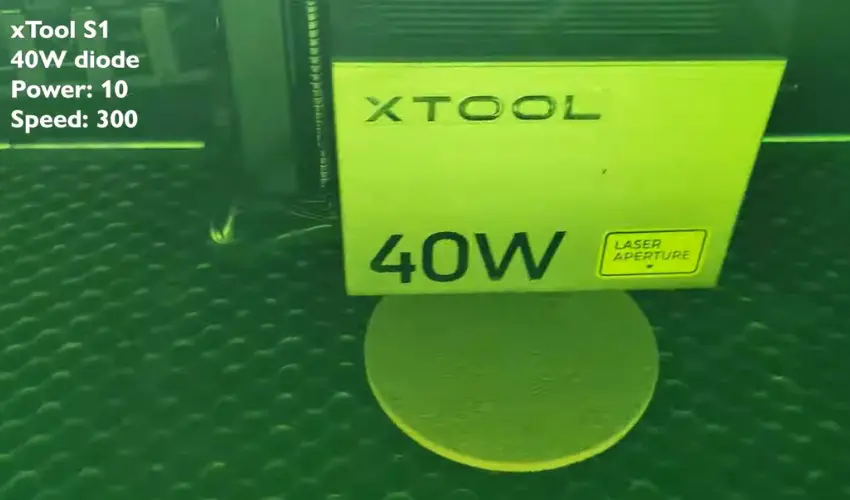
Price: ~$1,999 USD
Laser Type: 40W Diode
Best For: Cutting and engraving small-to-medium cork projects
Why It’s Great:
- Delivers precise, high-contrast engraving on cork sheets and pre-cut blanks.
- Enclosed design for safety and cleaner cuts.
- Compatible with the xTool RA2 Pro rotary for cylindrical cork pieces (like wine stoppers).
Recommended Use:
- Personalized gifts, small cork art, and brand merchandise.
3. xTool M1 Ultra 10W Hybrid Laser Cutter & Blade Machine – Best for Beginners
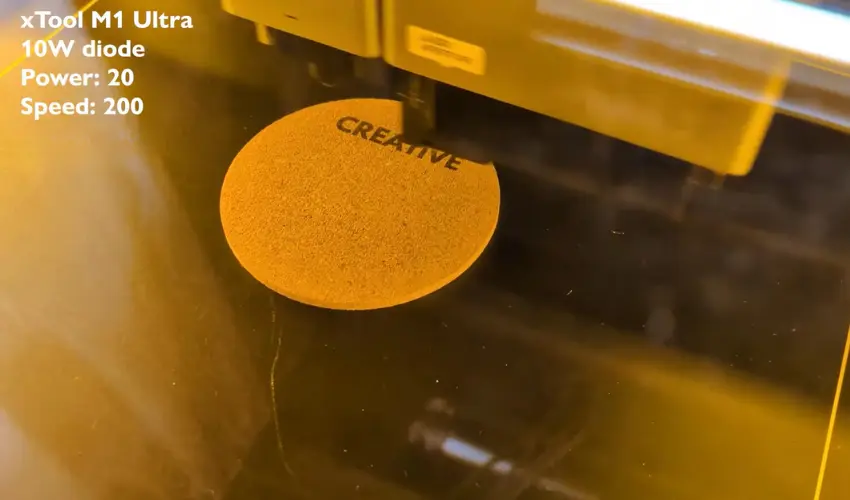
Price: ~$1099 USD
Laser Type: 10W Diode + Blade Cutter
Best For: DIY creators and hobbyists learning to engrave cork
Why It’s Great:
- Combines laser engraving with blade cutting for versatile crafting.
- Compact and beginner-friendly design fits any home workspace.
- Engraves cork coasters, labels, bookmarks, and thin sheets with clean detail.
Recommended Use:
- Light engraving on pre-cut cork coasters and thin cork fabrics.
Quick Comparison Table
Feature | xTool M1 (10W) | xTool S1 (40W) | xTool P2 (55W CO₂) |
|---|---|---|---|
Laser Type | Diode + Blade | Diode | CO₂ |
Power Output | 10W | 40W | 55W |
Engraving Area | 11.8″ × 15.1″ | 19.6″ × 12.5″ | 26″ × 14″ |
Best For | Hobbyists | Small business & crafters | Professional studios |
Cutting Depth | Up to 3 mm cork | Up to 5 mm cork | Up to 8 mm cork |
Air Assist | Optional | Built-in | Included |
Price (USD) | ~$1099 | ~$1,999 | ~$3,799 |
Fume Extraction | Desktop Air Purifier | AP2 Air Purifier | AP2 Air Purifier |
Ease of Use | ⭐⭐⭐⭐⭐ | ⭐⭐⭐⭐ | ⭐⭐⭐⭐ |
Pro Tip:
If you plan to engrave cork frequently, pair your laser with an xTool Air Purifier for optimal air quality and filter life. Cork emits fine particles and odors during engraving — proper filtration protects your workspace and machine.
Recommended Settings for Laser Engraving Cork
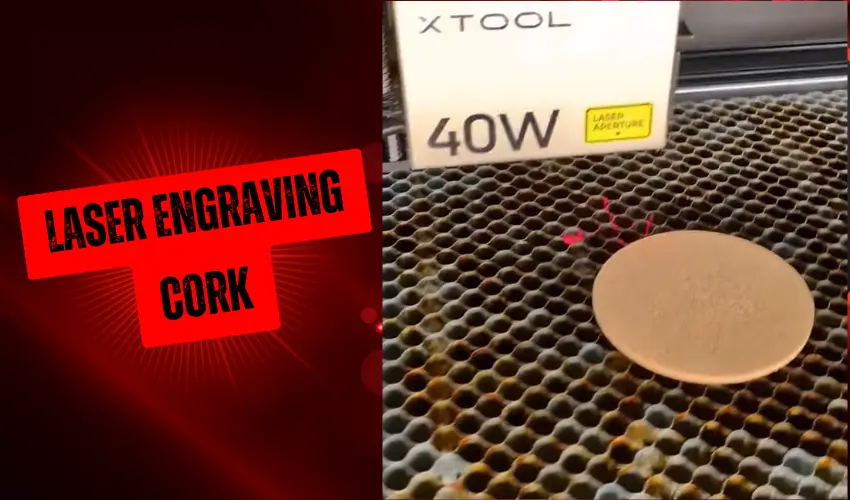
Here’s a good starting point for your first cork engraving tests. Always adjust based on your specific machine and material thickness.
xTool Laser Engraving Cork Settings Comparison Chart
Machine Model | Laser Type & Power | Best Use | Recommended Power | Speed (mm/s) | Passes | Air Assist | Notes / Tips |
|---|---|---|---|---|---|---|---|
xTool P2S | CO₂ Laser – 55W | Cutting and deep engraving thick cork (trivets, wall tiles) | 8–15% | 400–500 | 1 | ON | Ideal for 3–10 mm cork. Produces clean edges with minimal charring. |
xTool S1 (40W) | Diode Laser – 40W | Medium-depth engraving on coasters, sheets, and cork art | 10–20% | 300–400 | 1–2 | ON | Best for 2–6 mm cork. Use masking tape to reduce burn marks. |
xTool M1 (10W or 20W) | Diode Laser | Light engraving for thin cork sheets or keychains | 20–30% | 200–300 | 1–2 | Optional | For thin cork (≤3 mm). Avoid full cuts—edges may darken. |
Recommended Cork Materials & Design Ideas for Laser Engraving Cork
When it comes to laser engraving cork, not all cork materials perform the same. Choosing the right type ensures crisp engraving results, clean cuts, and long-lasting products. Below are the best types of cork for laser engraving — plus creative project ideas to inspire your next design.
Natural Cork Sheets
Best for: Engraving and cutting clean, flat designs
Material Type: 100% natural cork, uniform surface, 1–3 mm thick
Why It Works: Natural cork sheets engrave evenly and create high-contrast marks with minimal burning.
Best Uses:
- Custom coasters and trivets
- Laser-cut cork ornaments
- Signage or labels
Pro Tip: Use medium power and moderate speed to achieve rich, dark engravings with precise detail
Pressed or Composite Cork
Best for: Deep engraving and high-volume production
Material Type: Made from granulated cork fused with adhesives
Why It Works: More durable and consistent than natural cork, making it ideal for mass production.
Best Uses:
- Engraved cork tiles or boards
- Wall art or branding panels
- Promotional items
Note: Always use proper ventilation — adhesives in composite cork may emit mild fumes during engraving
Cork Coasters (Pre-Cut)
Best for: Quick engraving projects
Material Type: Dense, pre-finished cork discs
Why It Works: Ready-to-use blanks save time and are perfect for small laser engravers like the xTool M1 Ultra or S1.
Best Uses:
- Personalized drink coasters
- Wedding favors or branded giveaways
- Decorative tabletop pieces
Design Idea: Add vector patterns, monograms, or business logos for an elegant, handcrafted finish
Cork Fabric (Veneer Cork)
Best for: Flexible or textile-based projects
Material Type: Thin cork veneer backed with fabric or PU
Why It Works: Cuts easily with CO₂ or diode lasers and engraves shallowly for unique texture effects.
Best Uses:
- Wallets, handbags, and bookmarks
- Apparel tags or labels
- Laser-cut jewelry
Pro Tip: Use low power and higher speed to prevent scorching or warping the backing material
Cork Rolls (Soft or Adhesive-Backed)
Best for: Large-format designs and decals
Material Type: Thin, flexible cork on a continuous roll
Why It Works: Great for cutting shapes and lettering; easy to apply to walls, glass, or wood.
Best Uses:
- Custom cork wall decals
- Logo cutouts and inlays
- Large signage
Creative Design Ideas for Laser Engraving Cork
Project Type | Design Ideas | Recommended Machine |
|---|---|---|
Custom Coasters | Logos, quotes, geometric art | xTool S1 or P2S |
Wall Décor | Mandala, map, nameplate | xTool P2S |
Jewelry | Earrings, pendants, charms | xTool M1 Ultra |
Eco-Friendly Packaging | Tags, labels, stickers | xTool S1 |
Corporate Gifts | Engraved cork notebooks | xTool P2S |
Recommended Cork Blanks for Laser Engraving
Choosing the right cork blanks can make or break the quality of your laser engraving results. Whether you’re creating custom coasters, wall art, or branded keychains, the texture, thickness, and density of your cork matter a lot.
Below are some of the best cork blanks to use with CO₂ and diode laser machines like the xTool P2S, xTool S1, and xTool M1 Ultra.
Cork Coasters (Round or Square)
Best for: Personalized gifts, branding, barware, and event merchandise
Cork coasters are one of the most popular blanks for laser engraving. Their smooth surface and consistent thickness allow detailed designs, logos, or text to appear crisp and clean.
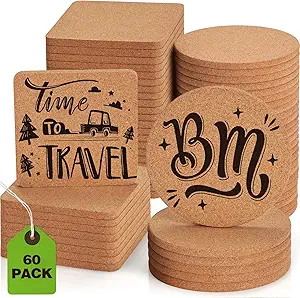
Use Case Ideas: Custom bar coasters, wedding favors, logo merchandise.
Cork Sheets and Rolls
Best for: Cutting custom shapes, signage, and decorative crafts
Cork sheets come in large, flexible panels that you can cut and engrave into almost any shape. They’re perfect for layered art projects or wall decor.
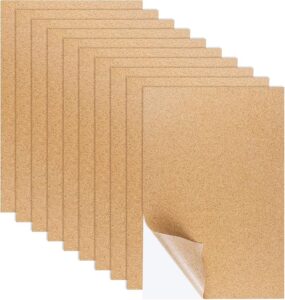
Use Case Ideas: Wall maps, decorative signage, jewelry backings.
Cork Trivets
Best for: Kitchen décor, home gifts, and branding larger designs
Trivets are thicker than coasters, allowing deeper engravings or cutouts. The extra surface area makes them ideal for detailed graphics and names.
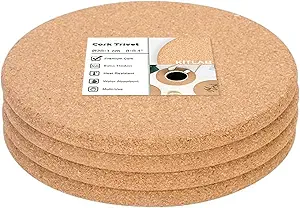
Use Case Ideas: Personalized kitchenware, gift sets, restaurant branding.
Pro Buying Tips for Cork Blanks
Tip | Why It Matters |
|---|---|
Choose uncoated cork | Coated cork can burn or release fumes |
Test engraving depth | Avoid burning through thin cork |
Store flat | Prevent warping before engraving |
Clean with mild alcohol | Removes oils or dirt before use |
Buy in bulk | Great for small business and batch engraving |
Laser Engraving Cork Preparation
- Choose the Right Material
Use smooth, flat, and untreated cork sheets or products. Avoid heavily textured or synthetic cork, which may not engrave evenly. - Clean the Surface
Wipe off dust and particles using a dry cloth. Clean surfaces yield crisper engravings. - Secure the Material
Cork is lightweight, so use masking tape or magnets to hold it flat on the laser bed to prevent shifting during engraving. - Mask the Surface (Optional)
Apply transfer tape if you want to minimize soot or burn marks, especially for high-power CO₂ lasers.
After Laser Engraving Cork: Cleaning and Finishing
- Remove Residue: Gently brush or vacuum the engraved area to remove dust.
- Optional Sealing: Apply a thin coat of matte sealer or clear finish to enhance contrast and protect from wear.
- Avoid Water-Based Cleaners: Cork absorbs moisture easily — stick to dry cleaning methods.
Best Sealants & Finishes for Laser-Engraved Cork
Cork’s natural absorbency makes it easy to engrave — but it also means the surface can collect dust, moisture, or oils over time. Applying a protective sealant not only enhances the engraved contrast but also improves durability and longevity, especially for frequently handled items like coasters, keychains, or notebooks.
Here’s a guide to the best sealants and finishes for cork laser engraving projects:
Type of Finish | Appearance | Application Method | Best For | Pro Tips |
|---|---|---|---|---|
Preserves natural cork texture with a subtle protective layer | Spray evenly 8–10 inches away; allow to dry 30 mins | Coasters, wall art | Choose a UV-resistant spray to prevent fading over time. | |
Slight gloss with a waterproof finish | Apply with foam brush or soft cloth | Keychains, drink labels | Use two thin coats for best results; let cure overnight. | |
Deepens color slightly; soft sheen | Rub in small circular motions; buff with clean cloth | Notebooks, jewelry | Food-safe option — ideal for eco-friendly projects. | |
Available in multiple finishes | Brush thin layer; air dry | Cork signs, decorative panels | Use matte finish to avoid glare on engraved designs. | |
Warm, natural finish; enhances engraved contrast | Apply with soft cloth, allow to soak and dry | Large wall art, decorative cork sheets | Avoid excess oil on dark engravings — may blur detail. |
Pro Tip:
Before sealing, gently brush engraved cork with a soft toothbrush or compressed air to remove soot and debris. This prevents streaking and helps the finish adhere evenly.
Why Seal Laser-Engraved Cork?
- Protects against moisture, dust, and stains
- Enhances engraving contrast and detail visibility
- Increases product lifespan and durability
- Improves overall aesthetic appeal for gifting or selling
Common Mistakes to Avoid When Laser Engraving Cork
Cork is a natural, lightweight, and porous material — which makes it perfect for laser engraving but also easy to damage if not handled correctly. To achieve clean, professional results, avoid these common mistakes most beginners make.
Using Too Much Laser Power
Cork burns easily due to its soft, cellular structure. Using excessive power or moving the laser too slowly can scorch the surface, leaving dark edges and smoke stains.
Pro Tip:
Start with low power (10–20%) and high speed (300–500 mm/s) settings. Gradually increase power only if the engraving appears too light. For CO₂ lasers like the xTool P2S, begin around 5% power for shallow engraving.
Skipping Air Assist or Ventilation
Without proper ventilation, cork releases fine dust and fumes that can discolor engravings or stick to your lens.
Pro Tip:
Always use Air Assist or an xTool Air Purifier to blow away debris and prevent smoke buildup. This keeps your designs crisp and your laser optics clean.
Not Securing the Cork Properly
Because cork sheets and coasters are lightweight, they can shift during engraving, leading to misaligned patterns or double lines.
Pro Tip:
Use honeycomb hold-down pins, masking tape, or a magnetic bed to keep your cork flat and stable. Check that your bed is level before starting.
Ignoring Focus and Distance Settings
If your laser isn’t properly focused, your design might appear fuzzy or unevenly engraved.
Pro Tip:
For diode lasers like the xTool S1 or M1 Ultra, double-check your focus using the auto-focus feature or manually adjust using a focus block. Even a 1–2 mm difference can blur fine details.
Forgetting to Mask the Surface
Unmasked cork can char more easily and collect soot around the engraved areas.
Pro Tip:
Apply laser masking tape or a low-tack painter’s tape over the surface before engraving. It reduces burn marks and gives your project a cleaner finish.
Not Testing on Scraps First
Every cork sheet can react differently depending on density, texture, and finish. Jumping straight to your final project is risky.
Pro Tip:
Always test your settings on a small piece from the same batch before engraving your main design. Note down the best power/speed combination for future projects.
Skipping Post-Engraving Cleaning
Soot and dust can dull your finished design if not removed immediately.
Pro Tip:
After engraving, gently wipe the surface with a soft cloth or isopropyl alcohol to remove residue. Avoid harsh scrubbing, which can tear delicate cork fibers.
Summary: Best Practices for Laser Engraving Cork
Step | Tip | Benefit |
|---|---|---|
Use low power | 10–30% power at high speed | Prevents scorching |
Enable Air Assist | Keeps design crisp | Reduces residue buildup |
Secure material | Use pins or magnets | Ensures clean lines |
Check focus | Auto or manual focus | Improves engraving sharpness |
Mask the surface | Use painter’s tape | Prevents burn marks |
Test first | Try on scraps | Saves material |
Clean gently | Wipe with alcohol | Enhances final finish |
Frequently Asked Questions
Can you laser engrave cork?
Yes! Cork is an excellent material for laser engraving. Its soft, porous texture burns easily under low laser power, creating sharp, dark engravings with great contrast. Both CO₂ and diode lasers can engrave cork effectively, though CO₂ lasers tend to produce slightly smoother results.
Does laser engraving cork smell or produce fumes?
Yes — when engraving cork, a light, burnt wood smell is common. It’s not harmful in small amounts, but proper ventilation or an air purifier is highly recommended. The smell usually dissipates quickly after engraving.
How do I prevent scorch marks or uneven burns on cork?
To avoid dark burn marks:
Use masking tape or transfer tape on the surface to absorb excess heat.
Enable Air Assist if your machine supports it.
Lower the power and increase speed slightly for lighter burns.
Keep the laser properly focused — cork’s uneven surface can cause inconsistent results.
Final Thoughts
Laser engraving cork is a fun and rewarding process that blends creativity with sustainability. With the right laser settings and preparation, you can achieve crisp, professional-quality results every time. Whether you’re crafting custom coasters, branded merchandise, or home décor, cork is one of the easiest and most beautiful materials to work with.
